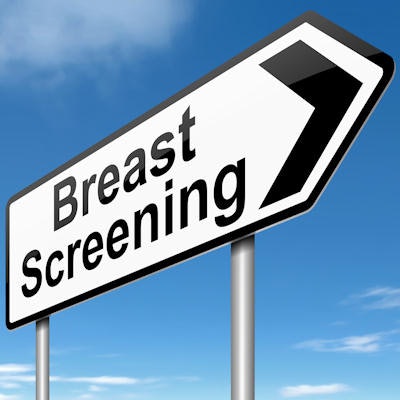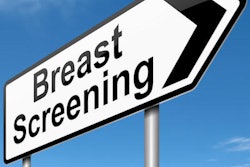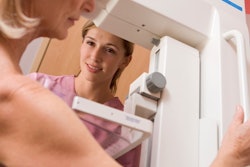
Women at average risk for breast cancer should start annual mammography screening at the age of 40, according to American College of Radiology (ACR) guidelines published online June 23 in the Journal of the American College of Radiology.
The ACR has remained firm in its position on when breast cancer screening should start and how often, despite differences in recommendations from other organizations such as the U.S. Preventive Services Task Force (USPSTF) and the American Cancer Society (ACS). And differences continue to develop: On June 23, one the ACR's traditional allies in its screening recommendation, the American College of Obstetricians and Gynecologists (ACOG), updated its guidelines to state that, at age 40, women should begin to discuss with their doctors when to start screening rather than begin routine screening itself.
 Dr. Debra Monticciolo from Texas A&M University.
Dr. Debra Monticciolo from Texas A&M University.But the ACR's guidelines reflect science that supports the benefits of early detection, wrote a team led by Dr. Debra Monticciolo of Texas A&M University and Scott & White Medical Center in Temple, TX.
"Our recommendation is based on maximizing proven benefits, which include a substantial reduction in breast cancer mortality afforded by regular screening and improved treatment options for those diagnosed with breast cancer," the group wrote. "Since 1990, the death rate [for breast cancer] has steadily declined by at least 38% through 2014. Although therapies have improved, screening has had a greater impact on mortality reduction."
Big benefits
Screening mammography has been shown to reduce breast cancer mortality through a variety of studies. These include randomized controlled trials (RCTs), which have found an overall risk reduction of 22% and an advanced cancer risk reduction of at least 20% in women invited to screening.
Even so, randomized controlled trials do have limitations: They don't necessarily give appropriate estimates of the magnitude of the reduction of breast cancer mortality, since they can be contaminated by the fact that not all women invited undergo screening, and yet these women are still counted in control cohorts. In addition, the trials began between 26 and 52 years ago, using imaging techniques and technology that are now obsolete.
"One of the concerns that prompted our report is that groups such as the USPSTF are depending too much on old data," Monticciolo told AuntMinnie.com. "They're relying on RCTs -- the most recent of which is 26 years old -- and all of these studies used film, not digital, technique. Many used only a single view for the mammogram. We need to evaluate mammography in a way that reflects current practice."
Given the limitations of RCT data, Monticciolo's group looked to current and larger scale observational study data such as that from the Euroscreen Working Group. The group evaluated the impact of population-based screening on breast cancer mortality in Europe, finding a 25% mortality reduction among women invited to screen and a 38% mortality reduction among women who were actually screened. Australian and European case-control studies showed that breast cancer deaths were reduced by 49% in women who were screened, and the Pan-Canadian Study of Mammography Screening and Mortality from Breast Cancer, which included 2.8 million women, showed a decrease in mortality among screened women of 40% (range, 27% to 59%), a reduction consistent across all age groups, even women 40 to 49.
Stateside, in 2009, the Cancer Intervention and Surveillance Modeling Network (CISNET), which develops models of breast cancer screening benefits and harms under various screening protocols, found that mean mortality reduction is greatest with the strategy of annual screening between the ages of 40 and 84, compared with the ACS' recommendation of screening annually from ages 45 to 54 then biennially from 55 to 79 and the USPSTF's recommendation of biennial screening from ages 50 to 74.
Indirect data also support the strategy of annual screening starting at 40, according to the group.
"Before the widespread use of mammography in the mid-1980s, the death rate from invasive breast cancer had been unchanged for 50 years," the team wrote. "From 1990 to 2014, there was a 38% reduction in breast cancer mortality in the United States. There has been a similar magnitude reduction in advanced cancers in the mammography era."
Handling harms
Yes, there are risks from mammographic screening, including recalls for additional imaging and/or biopsy, increased patient anxiety, and overdiagnosis. Recall rates range from 9.6% to 11.6%; this higher recall rate of 11.6% is associated with a cancer detection rate of 5.1 cancers per 1,000 exams, sensitivity of 87%, and specificity of 89%, Monticciolo and colleagues wrote. But low recall rates may not be best for cancer detection: Rates of 10% to 14% have been associated with higher cancer detection than those under 10%.
And is the risk of getting recalled or undergoing a biopsy high enough to constitute harm? Not necessarily, according to the researchers.
"A woman undergoing annual screening between the ages of 40 and 49 years would experience a recall for additional imaging once every 12 years ... [and] a woman who undergoes annual screening from ages 40 to 49 ... has a 0.67% change of undergoing a biopsy each year," the group wrote.
As for patient anxiety -- often caused by recalls and biopsies -- Monticciolo and colleagues acknowledged that it happens, but noted that it is also subjective and that there is no consensus among investigations of the issue regarding the extent of patient anxiety and how it affects screening behavior. One study found that, when asked directly, 86% of women were willing to deal with recalls in exchange for opportunities to find cancer earlier, they wrote.
"Women are smart about this," Monticciolo said. "They know that breast cancer is the most common cancer in women, they know friends and family who have had it, and they want to find cancer early, even if they have to endure some false positives."
Finally, regarding overdiagnosis, attempts to measure it have been mixed -- a fact highlighted by the wide range of estimates of its frequency, from 0% to 54%, the group wrote. The truth is that modern medicine diagnoses and treats many conditions (for example, high cholesterol and hypertension) before symptoms develop without concern about the level of diagnosis.
"The pejorative use of 'over' in 'overdiagnosis' implies excessive or unnecessary diagnosis and suggests that the level of diagnosis among unscreened women is ideal," Monticciolo's group wrote. "However, because screening reduces mortality, the optimal level of diagnosis seems to be at the screening level and not at that of symptomatic disease."
By women, not for women
In the end, women are the ones who need to evaluate the risks and benefits of mammography screening, according to Monticciolo and colleagues. Mammography isn't perfect, but image-based screening is currently the best way to find tumors before they are detectable clinically. The technology's benefits are maximized when women start annual screening at 40.
"When to start screening should be decided by women, not for them," Monticciolo said. "Women need to know the facts and to understand the evidence -- both of which support mammography's benefits."




















